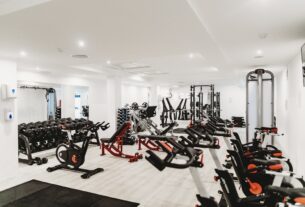Setting clear and achievable goals is crucial for initiating a successful fitness regimen. Objectives should be specific, measurable, and tailored to individual aspirations, whether they involve weight loss, muscle gain, improved endurance, or overall health enhancement. For instance, rather than a vague goal like “losing weight,” a more effective approach would be to aim for “losing 10 pounds in 3 months.” This precision enables progress tracking and maintains motivation throughout the journey.
Goals should also be realistic and attainable, taking into account current fitness levels, lifestyle constraints, and personal commitments. For example, individuals with demanding schedules might find it more practical to aim for 30-minute workouts four times a week, rather than daily two-hour sessions. By establishing achievable targets, individuals increase their likelihood of maintaining commitment and avoiding discouragement associated with overly ambitious goals.
Key Takeaways
- Setting clear and achievable goals is essential for staying motivated and tracking progress.
- Creating a consistent workout routine helps to build discipline and maintain momentum.
- Incorporating both strength training and cardio into your workouts ensures a well-rounded fitness regimen.
- Focusing on proper nutrition and hydration is crucial for fueling your body and supporting your workouts.
- Getting adequate rest and recovery is necessary for muscle repair and overall well-being.
- Monitoring progress and making adjustments allows for continuous improvement and adaptation to your fitness journey.
- Seeking professional guidance and support can provide valuable expertise and accountability for reaching your fitness goals.
Creating a Consistent Workout Routine
Creating a Consistent Workout Routine
Scheduling Regular Exercise Sessions
Once you’ve established your fitness goals, the next step is to create a consistent workout routine that aligns with your objectives. Consistency is key when it comes to seeing results, so it’s important to schedule regular exercise sessions into your weekly calendar. Whether you prefer to work out in the morning, during your lunch break, or in the evening, finding a time that works for you and sticking to it will help you build a habit of regular physical activity.
Designing a Balanced Workout Routine
When designing your workout routine, it’s important to incorporate a mix of cardiovascular exercise, strength training, and flexibility work. This balanced approach will help you improve your overall fitness level and prevent boredom or burnout from doing the same type of exercise every day. For example, you could plan to do cardio activities like running or cycling on Mondays, Wednesdays, and Fridays, and incorporate strength training with weights or resistance bands on Tuesdays and Thursdays.
Varying Your Workouts for a Well-Rounded Fitness Regimen
By diversifying your workouts, you’ll keep things interesting and challenge different muscle groups for a well-rounded fitness regimen.
Incorporating Strength Training and Cardio

Incorporating both strength training and cardio into your workout routine is essential for achieving a balanced and effective fitness program. Strength training helps build muscle mass, increase bone density, and boost metabolism, while cardio exercises improve cardiovascular health, burn calories, and enhance endurance. By combining these two types of exercise, you’ll be able to target different aspects of your fitness and achieve a well-rounded level of physical conditioning.
Strength training can involve using free weights, resistance bands, or weight machines to work various muscle groups in the body. It’s important to focus on proper form and technique to prevent injury and maximize the benefits of each exercise. Additionally, gradually increasing the intensity and resistance of your strength training workouts will help you continue to challenge your muscles as they adapt and grow stronger over time.
Cardiovascular exercise encompasses activities that elevate your heart rate and increase oxygen consumption, such as running, swimming, cycling, or dancing. These activities help improve heart and lung function, burn calories, and boost overall stamina. It’s important to vary your cardio workouts to prevent plateaus and keep your body continuously adapting to new challenges.
For example, you could alternate between high-intensity interval training (HIIT) sessions and longer, steady-state cardio sessions to keep your workouts dynamic and engaging.
Focusing on Proper Nutrition and Hydration
| Metrics | 2019 | 2020 | 2021 |
|---|---|---|---|
| Water intake (liters) | 2.5 | 2.7 | 3.0 |
| Vegetable servings per day | 3 | 3.5 | 4 |
| Fruit servings per day | 2 | 2.5 | 3 |
| Protein intake (grams) | 60 | 65 | 70 |
In addition to regular exercise, proper nutrition and hydration play a crucial role in achieving your fitness goals. Fueling your body with the right nutrients and staying adequately hydrated will support your workouts, aid in muscle recovery, and help maintain overall health. A balanced diet that includes a variety of fruits, vegetables, lean proteins, whole grains, and healthy fats will provide the energy and nutrients needed for optimal performance during exercise.
It’s important to pay attention to portion sizes and meal timing to ensure that you’re consuming the right amount of calories to support your activity level without overeating. Eating smaller, balanced meals throughout the day can help regulate blood sugar levels and prevent energy crashes during workouts. Additionally, staying hydrated by drinking plenty of water before, during, and after exercise will help maintain proper body function and prevent dehydration.
Avoiding processed foods high in sugar, sodium, and unhealthy fats will also contribute to better overall health and fitness. Instead, focus on whole foods that are nutrient-dense and provide sustained energy throughout the day. Planning and preparing meals ahead of time can help you make healthier choices and avoid reaching for convenient but less nutritious options when hunger strikes.
Getting Adequate Rest and Recovery
While it’s important to stay committed to your workout routine and maintain a healthy diet, it’s equally crucial to prioritize adequate rest and recovery for optimal fitness results. Giving your body time to recover between workouts allows muscles to repair and grow stronger, reduces the risk of injury, and prevents burnout from overtraining. Aim for 7-9 hours of quality sleep each night to support overall well-being and muscle recovery.
In addition to sleep, incorporating rest days into your workout schedule is essential for allowing your body to recover from intense exercise sessions. On rest days, focus on low-impact activities like stretching, yoga, or leisurely walks to promote blood flow and flexibility without putting additional stress on muscles and joints. This active recovery can help reduce muscle soreness and improve overall mobility.
Incorporating relaxation techniques such as meditation or deep breathing exercises can also help manage stress levels and promote mental well-being. Stress can have a negative impact on physical performance and recovery, so finding ways to unwind and decompress can contribute to better overall fitness outcomes. By prioritizing rest and recovery as part of your fitness routine, you’ll be able to sustain long-term progress without risking burnout or injury.
Monitoring Progress and Making Adjustments

Here is the rewritten text with 3-4 Monitoring Progress: The Key to Achieving Fitness Goals
Regularly tracking your progress is crucial to achieving your fitness goals. By monitoring changes in your weight, body measurements, strength levels, endurance, or overall energy, you can gain valuable insights into the effectiveness of your current fitness plan. This information helps you identify areas of improvement or areas where you’re excelling, allowing you to adjust your approach accordingly.
Listening to Your Body: A Guide to Making Adjustments
In addition to physical measurements, paying attention to how you feel during workouts and throughout the day can offer valuable feedback on the impact of your fitness routine on your overall well-being. If you experience discomfort or fatigue during certain exercises, it may be time to modify your approach or seek guidance from a fitness professional to ensure proper form and technique.
Breaking Through Plateaus: Strategies for Success
Making adjustments to your workout routine or nutrition plan based on your progress can help keep your fitness journey dynamic and effective. For example, if you’ve reached a plateau in weight loss or muscle gain, changing up your workout routine with new exercises or increasing the intensity of your cardio sessions can help jumpstart progress. Similarly, adjusting your meal plan to include more protein or healthy fats can support muscle recovery and energy levels during workouts.
Seeking Professional Guidance and Support
Seeking professional guidance from certified personal trainers, nutritionists, or health coaches can provide valuable support and expertise as you work towards your fitness goals. These professionals can offer personalized workout plans, nutrition advice, and motivation to help you stay on track and make progress in a safe and effective manner. Whether you’re new to exercise or looking to take your fitness routine to the next level, working with a professional can provide valuable insights and accountability.
In addition to professional guidance, finding support from friends, family members, or workout buddies can also contribute to a positive fitness experience. Having a support system can help keep you motivated, hold you accountable for sticking to your routine, and provide encouragement during challenging times. Sharing your fitness journey with others can create a sense of community and camaraderie that makes the process more enjoyable and sustainable.
In conclusion, achieving fitness success requires setting clear and achievable goals, creating a consistent workout routine that includes both strength training and cardio exercises, focusing on proper nutrition and hydration, prioritizing rest and recovery, monitoring progress regularly, making adjustments as needed, and seeking professional guidance and support when necessary. By following these guidelines and staying committed to your fitness journey, you can achieve lasting results that contribute to improved health and well-being for years to come.
If you’re interested in learning more about fitness and wellness, check out this article on dotbanca.com that discusses the benefits of incorporating strength training into your fitness routine. Results Fitness emphasizes the importance of strength training in their programs, and this article provides valuable information on how it can improve your overall health and fitness.
FAQs
What is Results Fitness?
Results Fitness is a fitness center that offers a variety of workout programs, personal training, and group fitness classes to help individuals achieve their fitness goals.
What types of workout programs are offered at Results Fitness?
Results Fitness offers a range of workout programs including strength training, cardio workouts, HIIT (High-Intensity Interval Training), and functional training to help individuals improve their overall fitness and health.
Do they offer personal training at Results Fitness?
Yes, Results Fitness provides personal training services with certified trainers who work with individuals to create personalized workout plans and provide guidance and support to help clients reach their fitness goals.
Are there group fitness classes available at Results Fitness?
Yes, Results Fitness offers a variety of group fitness classes such as yoga, spin, Zumba, and boot camp classes to provide a fun and motivating environment for individuals to work out together and stay active.
What are the benefits of joining Results Fitness?
Joining Results Fitness can provide individuals with access to professional guidance, a supportive community, and a variety of workout options to help them improve their fitness, strength, and overall well-being.



